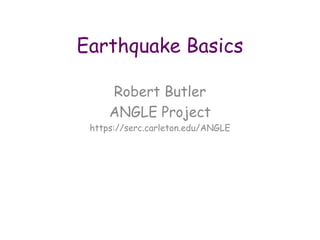
Earthquake Basics Presentation
- 1. Earthquake Basics Robert Butler ANGLE Project https://serc.carleton.edu/ANGLE
- 2. Stick-slip: Elastic Rebound Theory Jerky motions on faults produce EQs Three Fs of earthquakes: forces, faults, and friction. Slow accumulation and rapid release of elastic energy. Earthquake Machine
- 3. Three Basic Types of Plate Boundaries Transform (e.g. San Andreas Fault) Strike-slip faulting Magnitudes generally < 7
- 4. Three Basic Types of Plate Boundaries Divergent (e.g. spreading ocean ridge) Normal faulting Magnitudes < 6
- 5. Three Basic Types of Plate Boundaries Convergent (e.g. subduction zone) Magnitudes up to 9 or larger Depths to 700 km
- 6. Hypocenter or Focus: Point WITHIN Earth where EQ occurred. Epicenter: Location on Earth’s surface directly ABOVE the EQ.
- 7. Body waves (P and S) travel inside Earth. Surface waves travel along Earth’s surface. Body Waves and Surface Waves While P- and S- waves radiate outward in all directions, surface waves travel along the surface of the earth and decrease in amplitude with depth.
- 8. P Waves Are Pressure Waves P waves are fastest seismic waves.
- 9. S Waves Are Shear Waves S waves are slower than P waves but faster than surface waves.
- 10. Amplitude greatest at surface, decreasing with depth. Slower than P or S waves. Often are largest amplitude and most damaging seismic waves. Surface Waves
- 11. Human Waves Modeling P, S, and Surface Waves Seismic Slinky Human Waves
- 12. A seismograph detects and records earthquakes. A seismogram is the earthquake record. How do scientists detect earthquakes? When an earthquake occurs the seismic waves travel through the Earth to the seismic station where the information is transmitted to distant computers.
- 13. University of Portland AS-1 Seismometer M7.7 Earthquake off Northern Chile Nov 14, 2007 P waves ~12 min ~720 sec S waves ~22 min ~1320 sec Surface waves ~42 min ~2500 sec
- 14. Seismic Waves from Chile Earthquake USArray Animations QuickTime Animation
- 15. Seismic waves crossing the US recorded by the USArray.
- 16. Seismic waves crossing the US recorded by the USArray.
- 17. Distance of earthquake from seismometer? Determined from S arrival time - P arrival time. 4 min 45 sec 3300 km
- 18. Locating an Earthquake 1) Determine distance of EQ from three seismic stations by calculating the S minus P arrival times. 2) Plot them on the travel-time graph. 3) Intersection of the circles gives the location. 1 23
- 19. Moment Magnitude Pasta Quake QuickTime Animation
- 20. Magnitudes and Energies of Earthquakes MOST of the energy is released by ~20 magnitude-7 and larger earthquakes every year.
- 21. Earthquake Intensity Violence and Effects of Ground Shaking. QuickTime Animation
- 22. Effects of Near-Surface Geology Amplitude of oscillation increasing
- 23. Ground-Shaking Amplification Seismic waves are amplified as they pass from bedrock into basins filled with sedimentary rock.
- 24. Liquefaction What happens to a structure built on a weak foundation when an earthquake strikes? Liquefaction Niigata, Japan, June 16, 1964
- 25. Duration of Ground Shaking • Long duration can drive oscillation of large structures. • Long (bridges) and tall (high-rise) buildings vulnerable. • Long duration can cause fatigue of welds and bolts. Why does this matter? M9.0 Japan 2011 shaking lasted 6 minutes! Magnitude Duration of Shaking 5.0 – 5.9 6.0 – 6.9 7.0 – 7.9 8.0 – 8.9 9.0 – 9.5 2 – 15 seconds 10 – 30 seconds 20 – 50 seconds 30 – 90 seconds 1.5 – 6.0 minutes “moderate” “strong” “major” “great” “great”
- 26. Seismic Landslides in Anchorage, 1964 Government Hill Elementary SchoolFourth Avenue near C Street
- 27. Seismic Landslides in Anchorage, 1964 Block diagram of translational landslide.
- 28. Seismic Landslide Hazard Map Earthquake Hazard Maps
- 29. “Earthquakes don’t kill people ……. buildings that collapse during earthquake ground shaking kill people.” Build a Better Wall
- 30. Cripple wall failure Cripple Wall Failure A common problem for older wood- frame houses.
- 31. Nonstructural Damage Objects falling are common ”nonstructural” risks. Many are very easy to secure.
- 32. Nonstructural Damage Wood stoves Fuel tanks Fire is very common result of ground shaking.
- 33. Building Resonance Oscillating blocks experiment BOSS Model
- 34. Great Alaska ShakeOut 10:18 AM October 18, 2018